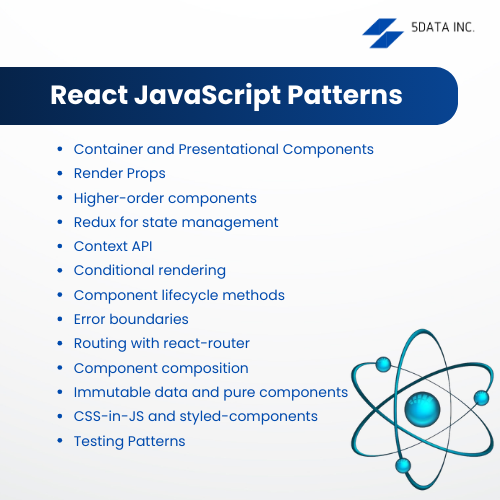React JS
React is a robust JavaScript library used for building interactive user interfaces due to several key features. This JavaScript library promotes modular UI development by breaking the interface into reusable components. It updates and renders changes efficiently by using a virtual DOM (Document Object Model) representation. It also enforces a unidirectional flow of data and optimizes updates by re-rendering and updating only the necessary parts of the UI. React has a wide range of libraries and tools, allowing for code reuse between web and mobile platforms. The active community ensures frequent updates and new features. When seeking the best mobile application development services, React is a top choice for creating cross-platform applications.React JavaScript Patterns
Recurring patterns and solutions in the React community improve code maintainability. Here are some popular React JavaScript patterns:1. Container and Presentational Components (Smart and Dumb Components):
This pattern categorizes components into two types: containers (smart components) that handle logic and data and presentational (dumb components) that focus on rendering UI.2. Render Props:
Passing a function as a prop enables reusable component logic.3. Higher-order components (HOC):
HOCs are functions that add props and behavior to components. They’re used for cross-cutting concerns like authentication, logging, or data fetching.4. Redux for state management:
Redux is a popular library for managing app state. It follows a unidirectional data flow and simplifies complex data interactions.5. Context API:
React’s Context API enables data propagation without prop passing; it is useful for global state and settings sharing.6. Conditional rendering:
Components can be rendered based on conditions, like if-else statements or ternary operators.7. Component lifecycle methods:
It is crucial to understand React component lifecycle methods for efficient side effect management and performance optimization techniques.
8. Error boundaries:
Error boundaries catch errors in child components to prevent app crashes.9. Routing with react-router:
React Router stands as a widely used library for client-side routing in React apps, allowing the creation of multi-page experiences.10. Component composition:
This pattern involves building user interfaces, creating reusable and smaller components, and composing them to form a complete UI.11. Immutable data and pure components:
Immutable data and compound components optimize React rendering by re-rendering only when data changes.12. CSS-in-JS and styled-components:
Writing CSS in JS libraries simplifies managing component-specific inline styles.13. Testing Patterns:
Ensure React code reliability with Jest and Enzyme unit testing.Acquiring Proficient Skills in React Code Development:
Unlocking React devtools full potential involves becoming a highly skilled and efficient React developer. Here are a few steps to help you do just that:1. Master JavaScript:
A thorough understanding of advanced JavaScript concepts and programming languages like closures, promises, arrow functions, async/await, and functional programming is essential to mastering as a React developer.2. Understand React’s core concepts:
Master React JS skills and react apps with components re-render, props, React hooks, state, reuse stateful logic, and the virtual DOM of any React application.3. Learn advanced React patterns:
Learn advanced React patterns like HOCs, render props, and custom hooks for reusable and maintainable code.4. Dive into state management:
For complex state management in functional components, explore Redux, Mobx, or React Context and learn when to use them.5. Routing:
Discover how to handle client-side routing using React Router or other routing libraries, as proper navigation is crucial for single-page applications.6. Optimize for performance:
To improve child component performance in React, minimize re-renders work, and use lazy loading, code splitting, and costly DOM operations, ComponentUpdate or PureComponent should be used.7. Advanced styling:
Use advanced CSS solutions like CSS-in-JS, preprocessors, and utility-first frameworks. Prioritize responsive design and animations for a polished, seamless user experience.8. Error handling:
It’s essential to know how to manage errors efficiently, and this can be done by creating error boundaries and handling exceptions effectively.9. Server-side rendering (SSR):
For better SEO, performance, and faster initial page loads, try SSR with frameworks like Next.js.10. Testing:
Learn React testing to ensure code quality by writing unit, integration, and end-to-end tests.11. React ecosystem:
Familiarize yourself with the broader React ecosystem. Learn about popular libraries and tools like React Native (for mobile apps), Gatsby (for static site generation), and more.12. Real-world projects:
Unlock React’s potential by applying your knowledge to real-world projects and implementing best practices.13. Community involvement:
Engage with the React community by attending meetup conferences and contributing to open-source projects both online and offline.14. Stay updated:
Stay updated on React by following official and community resources.15. Teach and mentor:
Teach others to reinforce your understanding. Create tutorial videos or mentor new developers.16. Problem-solving skills:
Developers often encounter complex performance issues and coding challenges and must troubleshoot to find solutions.17. Soft skills:
Good communication, teamwork, and time management are crucial in development. Unlocking React’s potential is a continuous learning journey.Improving The Performance Of React JavaScript App
To improve app performance, use memorization techniques to reduce redundant work with the assistance of a software application development company, further optimize performance with Redux, offload CPU-intensive tasks to web workers, convert your app into a web application or a PWA, use profiler tools, optimize API requests, inline critical CSS, leverage browser caching, use CDNs, and implement progressive loading. To build clean and maintainable React components, follow these best practices:- Break down your components.
- Use container and presentational component patterns.
- Follow the Single Responsibility Principle.
- Choose meaningful names.
- Use PropTypes and default values.
- Use object destructuring.
- Keep state minimal and localized using `useState` or `useReducer`.
Errors in React JS Applications
Handling errors in React applications is essential to provide a good user experience and maintain the stability of your application. Here are some common techniques and best practices established by application development software companies for error handling in a React project:1. Error boundaries:
Use error boundaries in React 16 to catch errors during rendering, in lifecycle methods, and constructors of the functional component hierarchy and tree below them. You can create error boundaries with `componentDidCatch` in class components or `ErrorBoundary` in functional components with proper guidance from a top application development company.2. Try-catch blocks:
Use try-catch blocks to handle errors in non-rendering parts of your code like event handlers or data fetching.3. Global error handlers:
Use ‘window.onerror’ or similar browser-specific mechanisms to handle unhandled errors. Log in and inform the user gracefully.4. Logging errors and network errors:
Use logging libraries like Sentry or LogRocket, catch blocks, and Axios to track errors and understand their root causes in production.5. Testing for error scenarios:
Test error scenarios using Jest and React Testing Library to ensure your components and error-handling mechanisms work properly.6. Server-side error handling:
Add error handling to backend APIs for better HTTP responses.Conclusion
Effective and maintainable React applications can be created by combining these patterns, which are not mutually exclusive. The right pattern depends on the project’s requirements and architecture. Performance optimization is an ongoing web development process, and it’s important to balance improvements with a focus on maintaining code quality and readability. By applying these techniques, you can enhance your React application’s error-handling capabilities, ensuring greater resilience and a user-friendly experience. Be adaptable to changes in web development. Challenge yourself to discover new ways to use React for powerful web applications.
About the Author...
Aparna Sushumna, a mother to a hyperactive toddler who is all over the house. I aspire to be a decent content developer. A Bachelorette of technology says my qualification but I anticipated being a singer. Thanks to the recession, I dwelled into various jobs, from coding to being a tech support executive to a help desk professional, only to conclude that there is something else I wish to do. Here I am to accomplish my profound passion for content writing. Music, nature, jewelry, beauty, mythology, life quotes, celebs, and their life, being my areas of interest.
